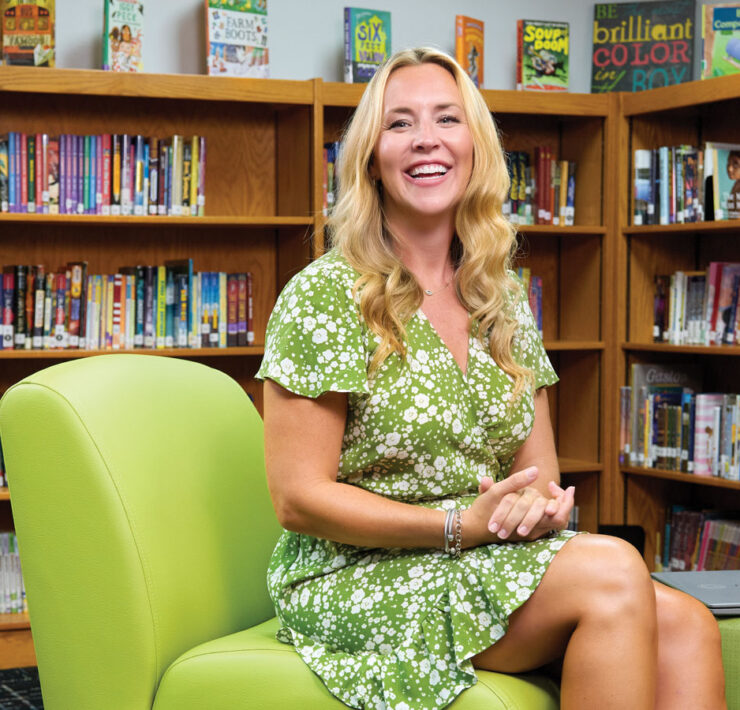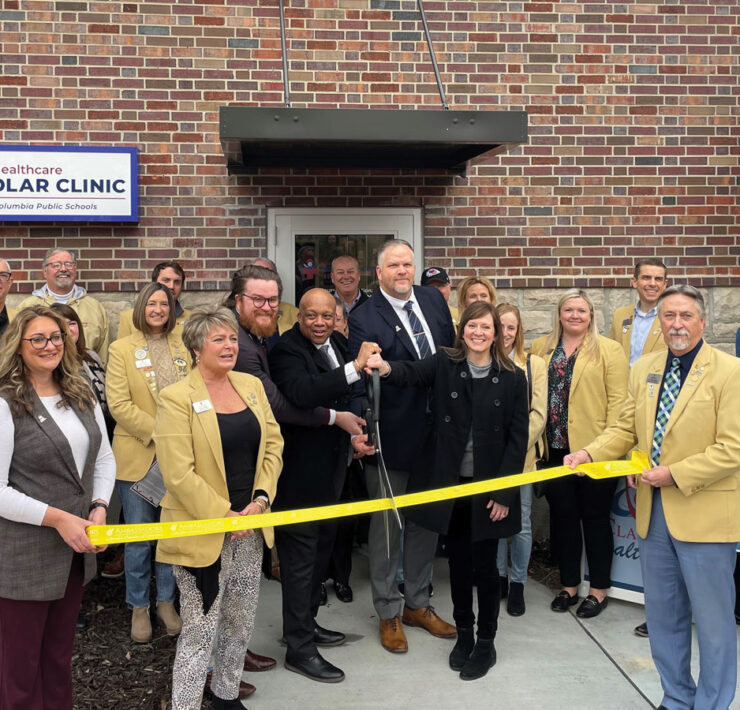Drawing the Districts
“Test scores have everything to do with the size of your house.”
Columbia Public Schools Superintendent Peter Stiepleman still remembers seeing that quip come across his Twitter feed. Anyone concerned about education in the United States knows about the achievement gap.
The term refers to a consistent difference in academic success between minority or low-income students and the rest of their classmates. The disparity can be seen in those who drop out and others who find success in college, but most often it shows up in standardized testing.
It’s endemic to public schools across the country. In 2013, the U.S. Department of Education tested 12th-graders in 11 volunteer states through its National Assessment of Educational Progress. In math, 7 percent of black students scored at or above the proficient level, while 33 percent of white students reached the mark. In reading, 49 percent of the students whose parents had graduated from college surpassed the proficient level, while only 24 percent of the students whose parents’ educations ended at high school scored as well.
Stiepleman and that Twitter quip are far from making light of the numbers. Like the rest of the country, CPS has been struggling with the problem, one that has been exacerbated in Columbia by the fact that the size of the district’s own house has been growing.
Creating the puzzle, parsing the data
The city opened its third comprehensive high school in the fall of 2013, and two new elementary schools are also in the works, meaning enrollment boundaries are being debated regularly.
A major part of the process has been trying to draw lines in ways that will maintain diversity and the associated achievement gap at relatively equal rates at all the district’s schools. The best scenario would see school enrollments that match the city’s demographics. U.S Census figures for 2010 show the area that CPS serves has an overall population that is 80.3 percent white, 10.8 percent black and 3.3 percent Hispanic.
However, using that goal as an overriding guide often creates maps filled with islands, peninsulas and other awkward formations that defy logic, and from the outset the Columbia Board of Education has asked the committees working on the puzzle to consider a set of principles that also includes items such as distance traveled to school and obvious boundaries such as major roadways.
Throughout, those involved have checked their work as it correlates to the achievement gap by leaning heavily on a regularly used standard: the number of students using the free and reduced-price lunch program at the schools, an indicator of poverty in enrollments.
Looking at the high schools, at first glance it’s not clear how well the boundaries have matched affluent houses with poorer ones, given the numbers listed by the Missouri Department of Elementary and Secondary Education for 2014.
- For Battle High School, the new building that welcomed its first senior class this fall, 50 percent of the enrollment uses the lunch program, 30.8 percent of the students are black and 6.4 percent are Hispanic.
- At Hickman High School, the lunch program is used by 32.6 percent of the enrollment, of which 18.9 percent are black and 5.8 percent are Hispanic.
- At Rock Bridge High School, 19.4 percent of the students use the lunch program, while 11.4 percent are black and 4.5 percent are Hispanic.
The figures suggest that, as it is across the country, diversity in Columbia is increasing. It also helps to parse the data in context with other considerations. If you factor in the three high schools’ total enrollments, Battle (1,080) actually has fewer students on the lunch program at about 540 than Hickman’s 590 (1,814 total enrollment).
Mostly, it’s hard to ignore what things look like when the high school boundary map is taken out for inspection, especially if there are maps from the City of Columbia’s Planning and Zoning Department nearby.
From Battle High School itself, located at the farther reaches of the northeast part of the city, you don’t have to look far to find undeveloped land.
The boundary lines for the new building’s enrollment also extend well south of Interstate 70 to include most of the district’s area east of Highway 63, a part of Columbia of which about half has been zoned as residential in the most recent version of the city’s East Area Plan for Future Land Use.
With higher-end developments like Old Hawthorne and The Vineyards already filling in the landscape in this area, the nature of Battle’s lunch program numbers in relation to what they are at the other two high schools is likely to see ongoing changes.
As far as Stiepleman sees it, Battle, with the lowest total enrollment, has room to grow along with the city.
“In the short term, we’re seeing major discrepancies with the FLR numbers at the high schools, but in the long term, that will change,” Stiepleman says. “The north and east parts of town will continue to develop, so we have to look at it from a long-term planning point of view.”
The super subgroup, a rallying cry
How the lunch program numbers will be spread throughout the schools is only part of the focus on the achievement gap in Columbia. Finding ways to help low-income students from across the district perform at higher levels is one of the most pressing challenges.
In district-wide results announced this August that examine the Missouri School Improvement Program performance report and other measurements of performance that the state uses to accredit schools, CPS students did well, bettering statewide and national results.
But the report also pointed out a “persistent gap in achievement among the demographic subgroups” at CPS. The subgroup in Missouri is comprised of students from four groups: black or Hispanic, those using the free and reduced-price lunch program, English language learners and students receiving special education services.
Although among students overall, more than 74 percent had Advanced Placement exam scores that would earn them college credit, CPS students from the subgroup earned only two out of 14 possible points in the MISP standards.
When the subgroup results are mentioned, Stiepleman is quick and firm in his response.
“That’s our rallying cry,” he says, and there’s not much doubt it is a high priority in his administration.
“Sometimes there’s some questions, concerns that we talk about the super subgroup quite a bit, but the truth of the matter is that it is going to be Columbia’s greatest area of need, of focus,” he says.
Perhaps more than anything the achievement gap is important because its implications extend beyond school buildings. Strong economies have many requirements, but a strong argument can be made that good educations for those who contribute to them is the best way to maintain them.
A report published this month by the Center for American Progress points to that relationship, noting what narrowing or eliminating the achievement gap could mean for the national economy. The report simulates the average annual increase in economic growth that would take place by closing the gap and improving the skill level of the American workforce.
Using projections from the U.S. Congressional Budget Office and anticipating increases in the black and Hispanic populations shown in U.S Census figures, as well as taking into account factors such as interest rates and inflation, it makes a bold statement.
Closing the gap, the report’s models show, could boost gross domestic product by $551 billion from 2014 to 2050. Extrapolating from there, the report goes on to show the correlating increase in government revenues, which could be lifted by $110 billion at the federal level and $88 billion at the state level.
The report’s intent is to show closing the achievement gap as an economic investment, something that moves beyond school board meetings. But Stiepleman is already sold.
“Communities with the best schools win,” he says. “It is the key to economic development. It’s in this community’s best interest to have great public schools and graduate kids that are ready to join the workforce, whether it’s after they graduate college or even beforehand.”
A push to succeed
At the high school level, CPS has been using programs from national nonprofits such as Equal Opportunity Schools and Advancement Via Individual Determination to nudge students who have potential but show lagging motivation in the right direction by pushing more challenging coursework.
The programs, which began at CPS before Stiepleman took over, hook into the fact that completion of Advance Placement courses in high school more often than not means completion of a college degree.
“You can’t attack or have any success on an achievement gap unless you’re getting kids into the higher-level courses,” says Stiepleman, who calls it a shift in thinking for the district.
“You say to a kid who already has self doubt, ‘This is going to be a hard course,’ and they hear, ‘You don’t think I can do it; I guess I won’t,’” he says. “So it was a change in how we speak to kids as well as removing some of those prerequisites that were creating a system of who can take the course and who can’t. It shouldn’t be that you have a certain GPA because that [taking an AP course] may be the thing that actually energizes a kid to care about school because they see relevance.”
In the end, though, Stiepleman comes back to community. CPS already gets support from groups such as the area’s Kiwanis Clubs, Columbia’s Rotaries and many other places. Assistance can come in the form of donations of winter clothes or technology such as iPads. Groups such as Big Brothers Big Sisters of Central Missouri also play a part.
But sometimes Stiepleman says he can feel like there’s no clear plan for getting results.
“What I think is going to be really helpful is to say, ‘Here are the goals of the school,’” he says. “What are you going to do for one of their goals? I don’t think we’ve ever done it that way. I think we’re getting better at focusing. We’re just not totally there yet.”








